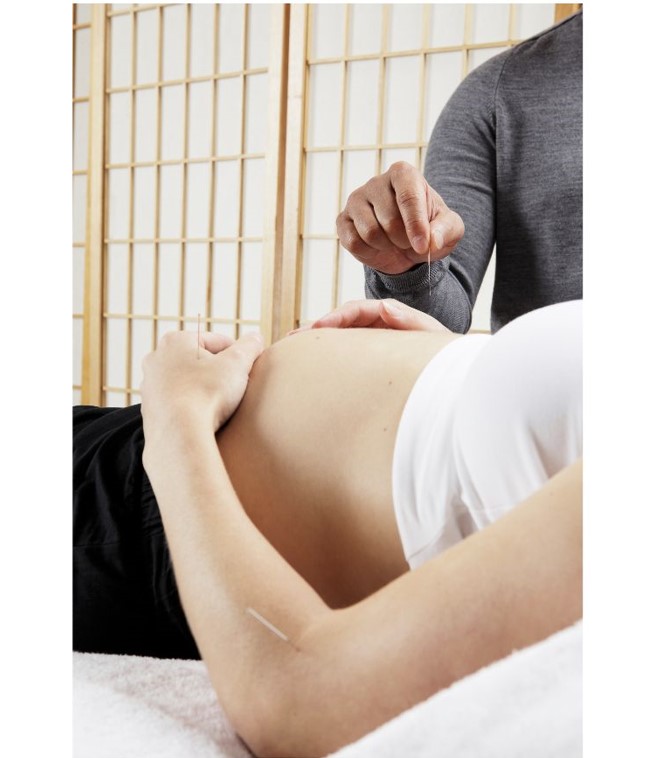During the course of pregnancy, it is common for mothers-to-be to experience various sorts of discomfort such as nausea and morning sickness, and joint pain. Due to the growing concerns about drug and medicine usage during pregnancy, non-drug interventions to resolve pregnancy related issues are getting increasingly common, one example of which is acupuncture treatment.
Some of the common applications of acupuncture in pregnant women include the management of issues such as pelvic and back pain, nausea and morning sickness, indigestion, depression, insomnia, gestational hypertension and fatigue. Research/Clinical studies has also used acupuncture to reposition the foetus in cases of where the foetus is in breech position, as well as induce labour (催产).
While most of the above conditions seem to be normal symptoms of pregnancy, if these issues are too severe, such as nausea and morning sickness, it might result in weight loss and dehydration and pose a danger to the mother and foetus if there is no intervention. In fact, there have been publications showing the effectiveness of acupuncture in relieving nausea and morning sickness.
While some symptoms would not directly threaten the pregnancy, issues such as pelvic or lower back pain could inhibit a woman’s range of motion and hinder their ability to move around independently and comfortably. Papers on acupuncture for pelvic and lower back pain for pregnant women have shown effectiveness in resolving the pain as compared to routine management, with no impact on foetal heart rate and birth conditions. No serious adverse events were recorded and minor adverse events include: sharp pain during acupuncture, worsening of pelvic pain after acupuncture, tiredness after acupuncture, etc. which managed to resolve and did not impact the stability of pregnancy.
Papers on acupuncture for pregnancy related insomnia showed that acupuncture was able to increase melatonin secretion and improved sleep quality with no serious adverse events observed, the only side effects were localised pain at the area of needling during the acupuncture treatment itself.
That being said, it has been recorded that certain acupoints are able to stimulate the Qi (气) in meridians (经络) in a way that can destabilize a pregnancy, and in some cases promote labour. Zhang & Tang (2022) summarize their findings on the modern understanding behind acupoints which are traditionally prohibited during pregnancy. A few of the points (SP 6 Sanyinjiao (三阴交), LI 4 Hegu (合谷) & GB 21 Jianjing(肩井)) were found to stimulate stronger uterine contractions and reduce labour duration, BL 60 Kunlun (昆仑) was found to be able to relax the muscles in the birth canal, allowing it to expand for smoother delivery. Lin et.al (2024) summarized the usage of LI 4-SP6 combination for inducing labour in the later stages of pregnancy and inducing abortion in early pregnancy by stimulating uterine contraction and cervical dilation, their research also suggested that the combination of both acupoints could result in the relaxation of cervical muscles, reducing the severity of birth pains. In view of this, TCM physicians are trained to exercise caution when using certain acupoints and avoid improper acupoint stimulation while treating pregnant women.
As long as appropriate care is taken in choosing acupoints, acupuncture for pregnant women is generally safe and doesn’t result in serious adverse events. In most cases, serious adverse events such as hypertension, pre-eclampsia, maternal or infant death, and birth anomalies that occurred among pregnant women who underwent acupuncture were found to be due to other factors. Common adverse events included temporary pain and bleeding at the site of acupuncture. We would like to point out that it is possible that many research neglected to report adverse events, and as those that included detailed reporting were mainly studies done in certain populations, they might not be representative of all women in general. We would like to highlight the importance of seeking the advice of a licensed TCM practitioner before starting any acupuncture treatment.
References
- Elden H, Ostgaard H, Fagevik-Olsen M, et.al. Treatments of pelvic girdle pain in pregnant women: Adverse effects of standard treatment, acupuncture and stabilising exercises on the pregnancy, mother, delivery and the fetus/neonate. BMC Complementary and Alternative Medicine. 2008,8(1).
- Foster NE, Bishop A, Bartlam B, et.al. Evaluating Acupuncture and Standard carE for pregnant women with Back pain (EASE Back): a feasibility study and pilot randomised trial. Health Technology Assessment (Winchester, England). 2016,20(33):1-236.
- Foroughinia S, Hessami K, Asadi N, et.al. Effect of Acupuncture on Pregnancy-Related Insomnia and Melatonin: A Single-Blinded, Randomized, Placebo-Controlled Trial. Nature and science of sleep. 2020,12:271.
- Smith C, Crowther C, Beilby J. Acupuncture to treat nausea and vomiting in early pregnancy: a randomized controlled trial. Birth. 2002,29(1):1-9.
- Carlsson CP, Axemo P, Bodin A, et.al. Manual acupuncture reduces hyperemesis gravidarum: a placebo-controlled, randomized, single-blind, crossover study. Journal of pain and symptom management. 2000,20(4):273-279.
- da Silva JBG, Nakamura MU, Cordeiro JA, et.al. Acupuncture for dyspepsia in pregnancy: a prospective, randomised, controlled study. Acupuncture in Medicine. 2009,27(2):50-53.
- Manber R, Schnyer RN, Lyell D, et.al. Acupuncture for depression during pregnancy: a randomized controlled trial. Deutsche Zeitschrift für Akupunktur. 2010,53(2):43-45.
- Levett KM, Sutcliffe KL, Betts D. Using Forbidden Points in Pregnancy: Adverse Outcomes and Quality of Evidence in Randomized Controlled Trials—A Systematic Narrative Review. Medical acupuncture. 2019,31(6): 346-360.
- Betts D, McMullan J, Walker L. The use of maternity acupuncture within a New Zealand public hospital: Integration within an outpatient clinic. N Z Coll Midwives J. 2016(52):45-49.
- Roemer AT, Kempfle T, Reuther I. Medical Acupuncture in Pregnancy: A Textbook. Stuttgart & New York: THieme; 2005.
- Levett KM, Smith CA, Dahlen HG, et.al. Acupuncture and acupressure for pain management in labour and birth: A critical narrative review of current systematic review evidence. Complement Ther Med. 2014,22(3):523-540.
- Park J, Sohn Y, White AR, et.al. The safety of acupuncture during pregnancy: A systematic review. Acupuncture in Medicine. 2014,32(3), 257-266.
- 林蕾, 李丹, 许金榜, 等. 合谷-三阴交穴组催产效应影响因素的思考. 中华养生保健. 2024,42(07):54-57.
张曦元, 唐潇旖. 妊娠期禁用腧穴古今探微. 按摩与康复医学. 2023,14(02):72-74.
Click to download PowerPoint


